I’ve been riding on clipless pedals for nearly two years now. Off and on I’ve thought about possibly switching to flat pedals...but something always made me change my mind. Not this time though. I’ve put in my order for some flat pedals, the Race Face Chester pedals to be exact. To compliment them, I also ordered a pair of Five Ten shoes. We’ll go over what the actually switch feels like but, first, let’s dig in on why I made the decision to switch.
The idea of putting flat pedals on a road bike is likely to sound like sacrilege to many riders. I’m sure many of you who predominantly ride road bikes are thinking that right now. As in, “Why would you do that?” Mainly because I want to buck the theory that you're not a serious cyclist unless you ride clipless. I’m concerned that I’m limiting myself by riding clipless. So, in an effort to find the best platform for my feet, I’m switching to flat pedals.
In a way this will be a bit of a mini review for a couple of different flat pedals: the Race Face Chester and the Pedaling Innovations Catalyst 1. I didn’t want this article to be primarily about these two pedals though. The focus is really why I switched to flat pedals and what went into it. Along the way, I learned about a few products so I figure I’d be thorough and share my thoughts on them as well. Let’s get started!
The Myth Behind Clipless Pedals
The argument over which is better, clipless vs flat pedals, is rather contentious. Right on up there with whether tubeless tires are worth it. Ask people who are predominantly road cyclists and they’ll almost always pick clipless over flats. But MTB cyclists? Bit of a mixed bag really. Which is why the choice between clipless versus flats for gravel will likely be up for debate over the coming years.
So which is really better? Which one is more efficient? Clipless or flat pedals? Turns out, neither clipless nor flat pedals are really more efficient over the other. GCN did their own flat vs. clipless pedals test and found there to be no real difference. In fact, depending on the rider, efficiency might be a smidge higher with flat pedals.
But what about speed? Can one make you faster over the other? Well, it really depends on the type of riding you’re doing. GCN did a further test to determine which is faster: clipless or flat pedals. Being that they are predominantly road cyclists a bit of confirmation bias was apparent in their test. They did say that, in the interest of subjectivity, they preferred clipless but confirmed that there isn’t any big difference in the efficiency between these pedal systems.
However, there was one very noticeable area where clipless pedals were better: sprinting. Both riders noticed a huge increase in performance with clipless pedals while sprinting. This is probably the one area where confirmation bias runs supreme with clipless pedals. The myth is that you sprint faster on clipless because you’re able to lift up on the pedal during the backstroke, thus giving you more power and speed. However, in reality, that’s not really why one can sprint faster on clipless pedals. The real reason why clipless are better for sprinting is more likely due to the ability to move one’s feet up and over the pedals more quickly than flat pedals allow. You can just pedal, pedal, pedal as fast as you can without any worry of your feet flying off the pedals.
Which leads to the big question: Which one? Clipless or flat pedals?
To answer that question, you first have to get over the myth that surrounds clipless pedals. Basically, the myth is that clipless pedals allow you to utilize all your leg muscles which in turn allows you to pedal more efficiently.
James Wilson of MTB Strength Training Systems talks about this in The Flat Pedal Revolution Manifesto, which he wrote some years ago in an effort to help debunk a lot of the myths surrounding clipless pedals. It’s a really deep dive and James has written a ton of information on the topic that’s worth reading.
In short, pulling “up” on a pedal isn’t really something the human body can do all that well. And yet cyclists are sold on the idea that only clipless pedals can give you that “magical” pedal stroke that leads to more efficient pedaling. James calls bullshit on this pretty hard and rightfully so. He doesn’t say that clipless are bad though...he’s just saying that the benefits that are being touted aren’t really true and that the use of clipless pedals need to be put into proper perspective.
Basically, if you’re a road cyclist, especially one who rides competitively, then you’ll likely see more benefits from clipless. That’s primarily due to the increase in speed while sprinting, which has nothing to do with a more efficient pedal stroke. The benefit is simply due to being clipped in with your feet planted on the pedals. Pretty simple logic: the more secure your feet are on the pedals the faster you’ll be able to pedal. But keep in mind that this only benefits you in situations that require higher performance. Unless you’re riding at higher speeds with plenty of sprinting, you probably won’t experience the real benefits of clipless pedals.
But if you’re a MTB cyclist, the question of which pedal system to use is a matter of preference. As GCN mentioned in one of their videos, some MTB racers like clipless due to the added speed it gives them in sprints off the starting line and such. However, technical riders prefer flats since it allows them to quickly plant a foot on the ground to navigate hairy turns and whatnot. That’s the main advantage of flats: the ability to put your foot onto the ground quickly when needed.
What about gravel riding? Which pedaling system would one chose for that? Well, like MTB, it’s a matter of preference. I think those who ride competitively at higher speeds tend to ride with clipless pedals. For more technical gravel rides though flat pedals might be more beneficial. It largely depends on the kind of gravel riding you’re doing and how technical that riding is.
Personally, I’ve found multiple situations where clipless pedals simply got in the way. There have been a number of gravel rides I’ve been on where the terrain would get a little hairy and require more technical riding skills. This has lead to situations where one of my feet would get stuck on the pedal and cause me to fall down. Not fun at all. If I had been riding on flats I likely would have been able to navigate the terrain better and not fall down. This is perhaps the biggest reason for making the switch to flat pedals. There are other reasons, which we’ll get to in the moment.
Race Face Chester Pedals: Simple Switch to Flat Pedals
Obviously, this isn’t my first rodeo with flat pedals. After all, the bike I rode as a kid was a flat pedal bike. Plus, the last two bikes I’ve owned were both flat pedal bikes. Heck, I even rode with the flat pedals that came stock with my Marin Nicasio road bike.
The difference this time is that I’m switching to a more modern flat pedal that’s geared for mountain biking. The flat pedals I’m used to have simple traction on them and are made for simple riding. MTB pedals are different in that they have metal pins on them that offer far more grip. So, yeah, new territory for me which, coming from clipless, should be interesting.
To make the switch, I first had to find a flat pedal. At first, I just wanted to find something that was relatively cheap to test with. After a bit of research, I landed on the Race Face Chester pedals, which are well received and have high marks in reviews. And, at just $50, they don’t break the bank.
With the clipless pedals I used before, I set the cleats back about as far back as I could take them. The reason is that I didn’t feel comfortable riding with the axles right on top of the balls of my feet. Moving them back closer to the arches felt better, which turns out to be a lot closer where my feet end up on the Chesters. With the Chesters though my feet are a little further forward with the axles centered right between the ball and middle arch of my foot. Didn’t take long to get used to simply because it’s so close to where I was riding with clipless.
The main thing that will take some time though is foot placement. Because I’m not clipping into anything, getting a good placement on the pedals is a bit of trial and error. Definitely was a little weird at first but, after a bit of riding, it got easier. This really isn’t any different than riding clipless for the first time. Just takes time to build up that muscle memory. I’m sure after a good number of rides, it’ll all come together and my feet will just find the right position every time.
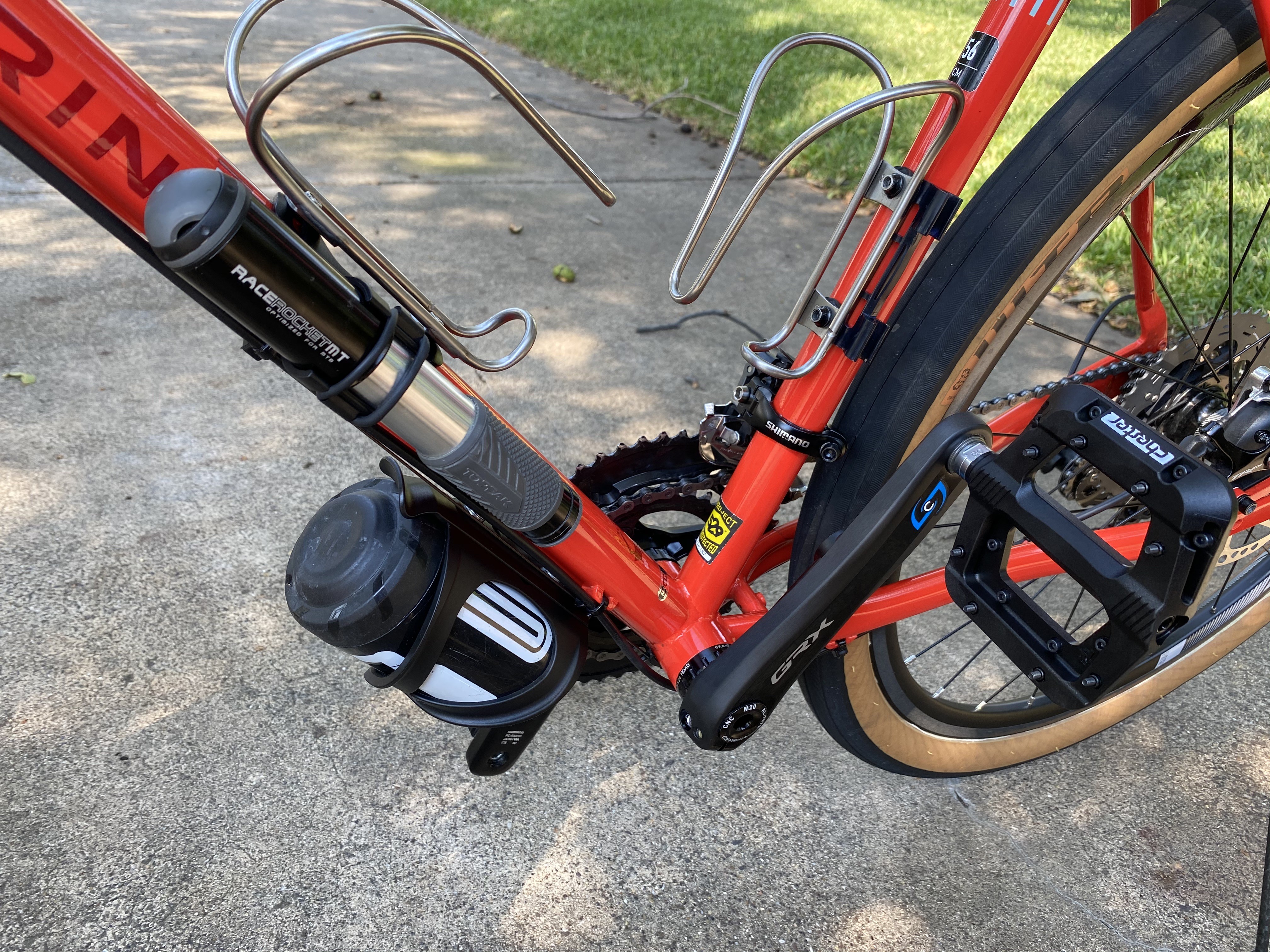
Now, there are two features that flat pedals are usually judged on: material and traction pins. For the material, most of the good flat pedals are usually alloy-based but nylon composite pedals like the Chester are starting to get popular. The upside of nylon pedals is that they’re cheaper to make, less prone to getting scratched up, while still being lightweight.
For the pins, flat pedals either come with pins that are screwed in from the top or, like the Chesters, from the bottom. Many MTB riders prefer the type that screw in from the bottom because the pins used are smaller, offer more grip, and are less prone to getting gunked up with dirt and grime after a hard ride.
I felt the Chesters right away when I started off riding. Most flat pedals with pins have a slight concave design to them so that they grip your feet a little more. Definitely noticed this with the Chesters. I could feel the pedals under my feet, which was a departure from any flat pedals I’ve ever ridden on. The grip on my feet was so good that shifting my position on the pedals took a little finagling. Not in a bad way though...just something I knew I would have to get used to. It’s a skill that will likely take a little time to build is all.
So, yeah, the Chesters appear to be a top-notch pedal that’s budget friendly and a great gateway pedal for those looking to switch to flat pedals.
Pedaling Innovations Catalyst Pedals: Taking Flat Pedals to the Extreme
At this point, I wondered how much better flat pedals can get. Are there improvements that could possibly benefit me as both a road and gravel cyclist? After riding the Chester’s for a few weeks, a thought occurred to me: How extreme can flat pedals get? Turns out there actually is an extreme. Enter the Catalyst pedals by Pedaling Innovations!
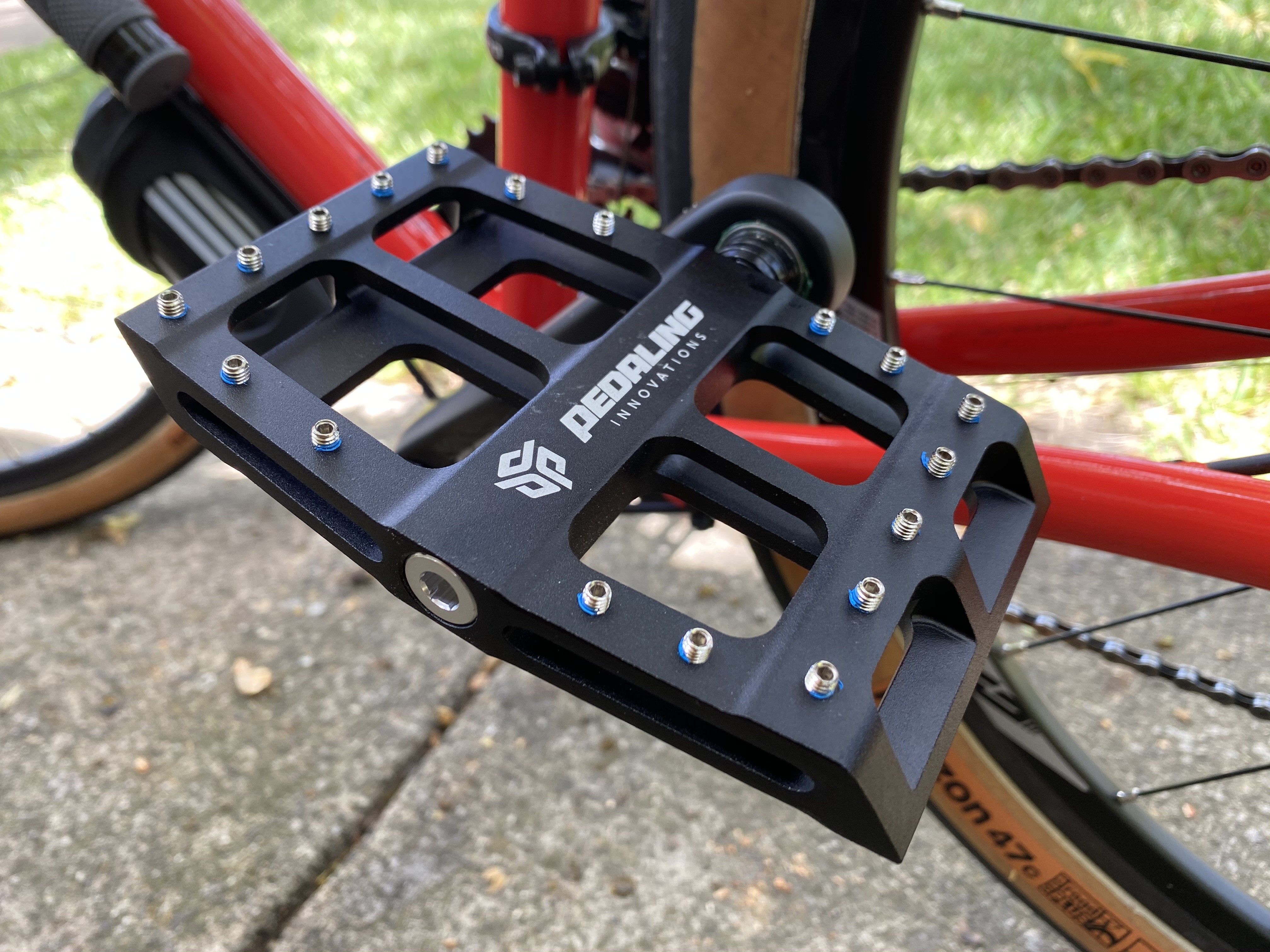
A few years ago, when I switched to clipless, I remember reading about some riders who customized their shoes for more of a midsole cleat position. Heck, even Joe Friel has talked about the use of a midsole position with clipless pedals. The idea has been on my mind so when I saw the Catalyst I knew right away that this would be a pedal worth considering. It’s basically taking the same idea that Joe Friel talks about and applying it to flat pedals, which is exactly what the Catalyst aims for: a midsole flat pedal.
If the Chester is representative of most flat pedals, then the Catalyst is an outlier. It’s a stupidly long pedal by comparison, which makes them about as unconventional as you can get for a flat pedal. The platform of the Catalyst measures in at a length of 143mm, almost a third longer than the Chester (101mm). “Why the long platform?”, you ask. Well, there’s a reason for that.
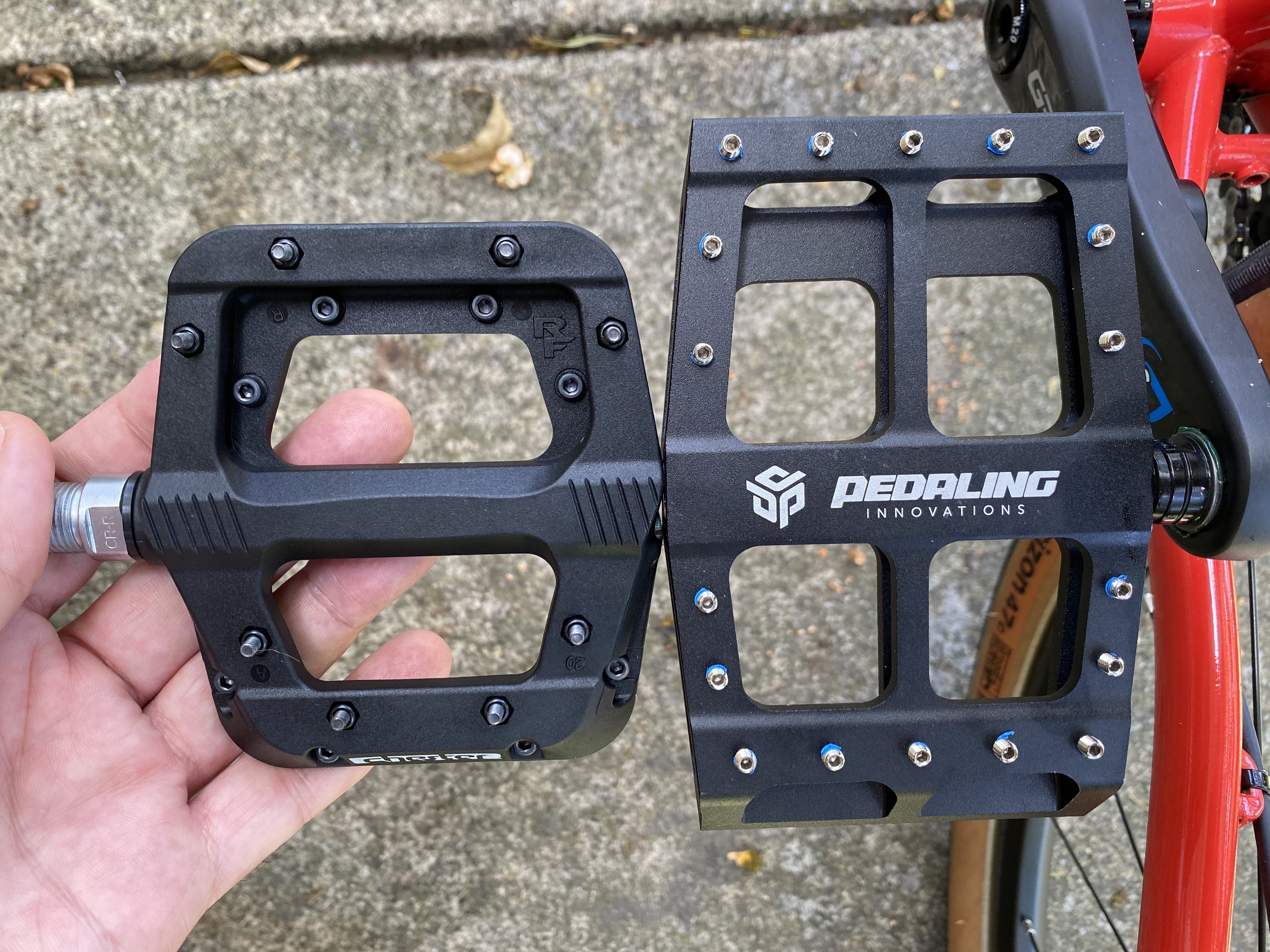
Remember that guy, James Wilson, I mentioned earlier? He’s the guy behind these pedals. The idea behind them is that, rather than placing the axle of the pedal on the ball of your foot, you place it under the arch. According to Wilson, this creates more power, efficiency, and comfort while at the same time removing stress from your feet, ankles, and calves. Pretty extreme idea considering they’re the only ones doing it right now.
The Catalyst comes in two flavors: the Catalyst 1 ($129), which is their original design, and the Catalyst Evo ($149) with an improved design. The main difference between the two is that the Evo is lighter, has a better bushing system, and has rear entry pins. While the Catalyst 1 has front entry grub screws for pins, there are also more of them: 18 pins per side (versus 10 per side with the Evo). The reduction of pins with the Evo is likely due to the fact that rear entry pins offer better traction and thus less of them are needed.
Price wise, the cost of the Catalyst pedals might seem a little pricey. But, when you consider that the price range for most alloy pedals is around $120-$180 (for good pedals!), the Catalyst pedals end up being more or less a mid-range pedal. They might not be super cheap but you do get what you pay for which is a really good quality alloy pedal.
I likely would have picked up a set of Catalyst Evo pedals but, at the time of this review, they were completely out of stock. This probably was a good thing since, honestly, I kind of prefer the bigger pins on the Catalyst 1. I’ll talk about why later on.
One thing you’ll notice about Pedaling Innovations is the sheer amount of information they provide about their products. That carries through from the website all the way into the packaging. In fact, inside the box of the pedals I received was a flyer that talked about some of the things I needed to know about these pedals. Pedaling Innovations goes out of their way to make sure I’m aware of the extra traction pins, changes that might be needed to my seatpost height and saddle position, servicing of the pedals, and how some frame designs can limit the mid-foot position. Based on all this info, I ended up moving my saddle forward a bit and will likely drop the height by a centimeter or so. Really appreciate all the info for sure!
After riding on the Chesters, stepping onto the Catalyst for the first time was a bit of a departure. Because of the length of the platform as well as the position of the axle, it forces you to plant your foot in such a way so that the axle lands much closer to the middle of your arch. This is, of course, by design and exactly what Pedaling Innovations was after.
Looking at the design of the pedal, you’ll notice that the forward facing part of the pedal is a bit longer than the backward facing side. Because of the length, your foot will rest pretty much in the middle of the pedal. With the axle dead center, this would place it just ahead of the center of the arch in your foot. So it appears they offset this by moving the axle a bit back on the platform. Match that up with the pin layout and the lack of a need for a concave platform and you end up with a rather interesting design.
While I’ve only been riding on them for just a few days I can already tell that I like them better than the Chesters. Don’t get me wrong, the Chesters are great pedals. For a more conventional flat pedal, you simply can’t go wrong with the Chesters. But if you’re after something that provides a better platform, the Catalyst is a step up for sure. The longer platform just adds more stability than what most flats provide, so much more that they practically eliminate the need for special shoes (more on that in the next section!). Stepping onto the Catalyst has a feel that fills up the middle of your foot in such a way that you don’t feel it sinking into the pedal hardly at all. It's that solid!
Grip on the pedals was good regardless of what shoes I wore; I never felt like my feet would slip. With the number of pins per side, along with the extra longer grub screws that come with the pedals, you can customize the grip quite a bit. At the moment, I’m pretty comfortable with the existing pins and layout. I’ll have to do a few really hard gravel rides to see if any updates are required. Some reviewers mentioned how the Catalyst doesn’t provide as much grip as other pedals. Hopefully a gravel ride will dispel that concern.
Like the Chesters, the Catalyst do take time to get used to. The shift in foot position is certainly a change but, like the switch to clipless pedals, will improve over time. Already though I can see how this design improves on the ability to pedal with more stability. I’m certainly eager to see how well they perform on longer rides. So far I’m quite pleased with what I’m experiencing with the Catalyst pedals.
Why I Like Flat Pedals
Ok, so after trying out a few flat pedals, let’s talk about what I like about my experience so far with them.
Flexible Choice In Shoes
By far the biggest advantage of flat pedals is the ability to use whatever shoes I want. Because I don’t have to worry about cleat compatibility, I can just wear whatever flat soled shoes I want.
With clipless, I actually struggled to find shoes that I felt were comfortable. Even then, none of them were truly satisfactory. The biggest problem I always had was getting them snug enough to hold my feet in place without being too snug. Too tight and they hurt the top of my feet when they swell. Too loose and my toes would dig into the front of my shoes when I’m out of the saddle.
Plus, the shape of them left a lot to be desired. Compared to a comfortable pair of sneakers, clipless compatible cycling shoes never seem to have designs that actually resemble the shape of feet.
With flat pedals, none of that is the case. In fact, I tried a number of different shoes that I already had, including a pair of Van’s, some Under Armour training shoes, Keen sandals, and a new pair of Five Ten shoes. While the Van’s and Under Armour shoes were do-able, I was amazed at just how well the Keen sandals worked. Seriously...who wouldn’t want to cycle in some cool sandals?
But the Five Ten Freerider Pro shoes I got worked beautifully and will likely be my go-to cycling show from now on. Compared to the Bontrager Foray shoes I was using before, these are actually more comfortable on my feet. They don’t have much in the way of ventilation so they’re a little hot. Other than that they work great.
Thanks to the longer platform of the Catalyst, I can keep my shoes snug and not have to worry so much about them being perfect. Because my feet are in a more natural position, even when out of the saddle, I haven’t had nearly as many instances of my toes digging into my shoes.
Freedom of Movement
With clipless, if your feet get tired there’s not a whole lot you can do to relieve it. Short of just taking your feet out of the pedals and shaking them, best you can hope for is to loosen up your shoes a bit...which can lead to your toes digging into the front of the shoe when pedaling hard.
Not the case with flat pedals! Having more freedom of movement is similar to the extra hand positions on your handlebars. If your feet get tired, you can just shift the position of your foot a bit on the pedal to get a bit of relief. In fact, James Wilson talks about this in his Flat Pedal Revolution Manifesto. In his view, our legs and feet actually want to have that kind of freedom of movement. Being that I’ve had rides where my feet got seriously tired, I have to agree with that assessment. If I had the ability to move my feet a bit I don’t think they would have been nearly as tired.
Possible Relief to Knees and Calves
One of the biggest benefits of flat pedals deals with the result that a shift of position in foot placement has on your legs. By shifting the axle back near the arch of the foot, it’s possible to get some relief to your calves and knees. I’ve had some anterior knee pain off and on in my right knee especially. So any relief is a good thing. I’ve always wondered if the use of clipless pedals was exacerbating it. It’s quite possible that a switch to flats may help immensely with this.
Ease In Maintenance
Lastly, due to the sheer simplicity of a flat pedal, they’re far easier to maintain than a clipless. With clipless, the mechanism that you clip the cleats into is an extra component of the pedals that does require a little TLC now and then. While most clipless pedals are pretty reliable, you still have to lube the joints now and then. Plus, if they fail or break, they’re not exactly easy to repair. In most cases, you have to just replace them.
By comparison, flat pedals are far and away less of a pain in the ass to maintain. About the only two things that require maintenance are the pins and axle. Most flat pedals use standardized pins which are super easy to replace. Axles usually hold up pretty well but, depending on the manufacturer, can be rebuilt which is far cheaper than replacing the entire pedal.
What I Miss About Clipless Pedals
I tried to come up with a short list of things I would miss about clipless pedals and, honestly, there really isn’t many. About the only thing I would truly miss is that locked-in feeling you have when riding on them. I think the psychological aspects of that are pretty powerful. For instance...
Once I got used to clipping in quickly, having the ability to take off quickly and not have to worry about foot placement is pretty reassuring. Coming off of clipless and back to flats, it takes time to gain that same reassurance. Nothing more unnerving than trying to take off in a hurry at a light only to find that your feet aren’t fully planted on the pedals. With clipless, that unnerving feeling is greatly reduced if you know you’re clipped in right.
Once clipped in, it’s nice to not having to worry about foot placement. Instead, you can put all your focus on the road ahead and just pedal. It’s one less thing to have muddling in your mind.
Other than that, I can’t say there’s anything about clipless pedals that I would miss in terms of any performance benefits. I’ve already proven that to myself with a one-hour tempo ride on my usual route. Zero difference in performance between my previous clipless pedals and the new flat pedals.
Conclusion
Hmm...I think I just talked myself into sticking with flat pedals.
Granted, I still have quite a few rides before I can say I’m super comfortable on the new flat pedals. But, like I mentioned above, if my time with clipless has taught me anything is that over time your body develops the muscle memory needed to be competent with new things on the bike. Just as it took time to get used to clipless pedals, so too will be the case with flats.
In the short time I reviewed them, I can say confidently that they have already proven to be a better fit for my riding style. And that’s really saying something. I thought it would take weeks to find my groove with them. Nope! Took less than a week to convince me of their efficacy.
Later on, once I’ve fully broken them in and ridden a good number of rides, I’ll revisit them as part of a long term review of flat pedals. Till then, I’ll keep at it and will enjoy the new freedom that they bring.
Keep calm and pedal on!
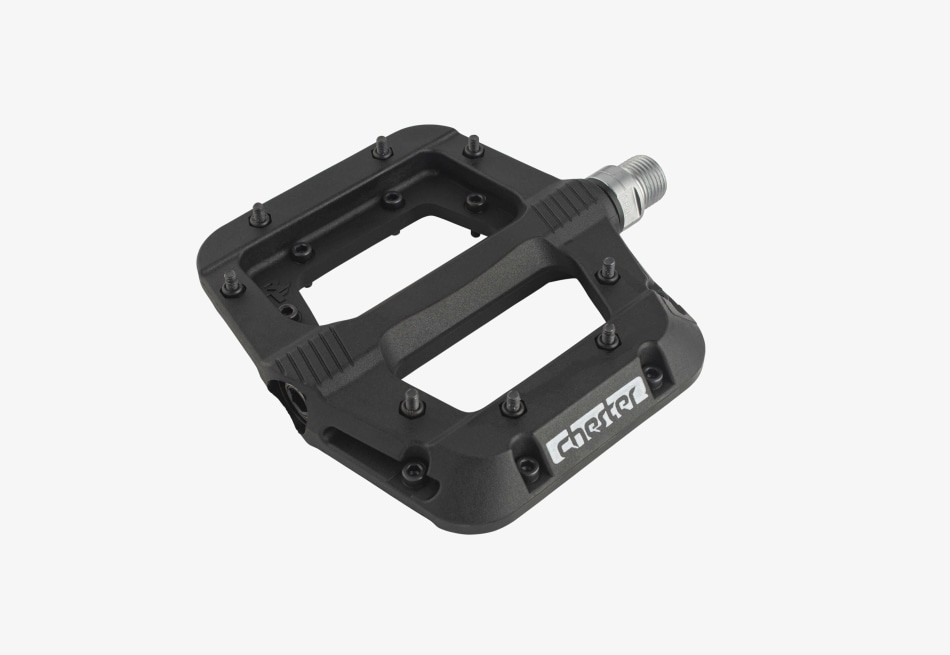
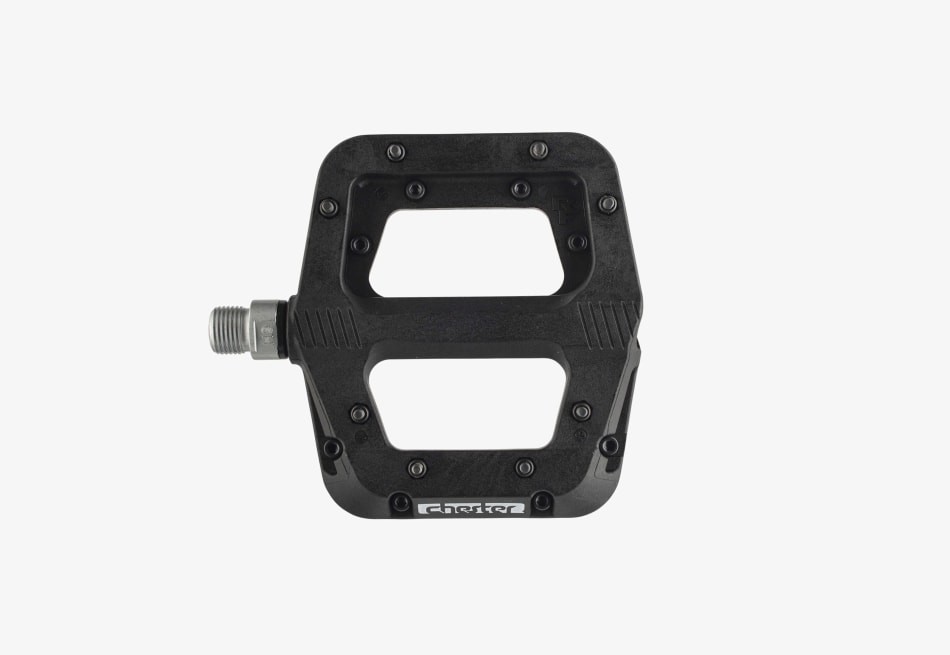
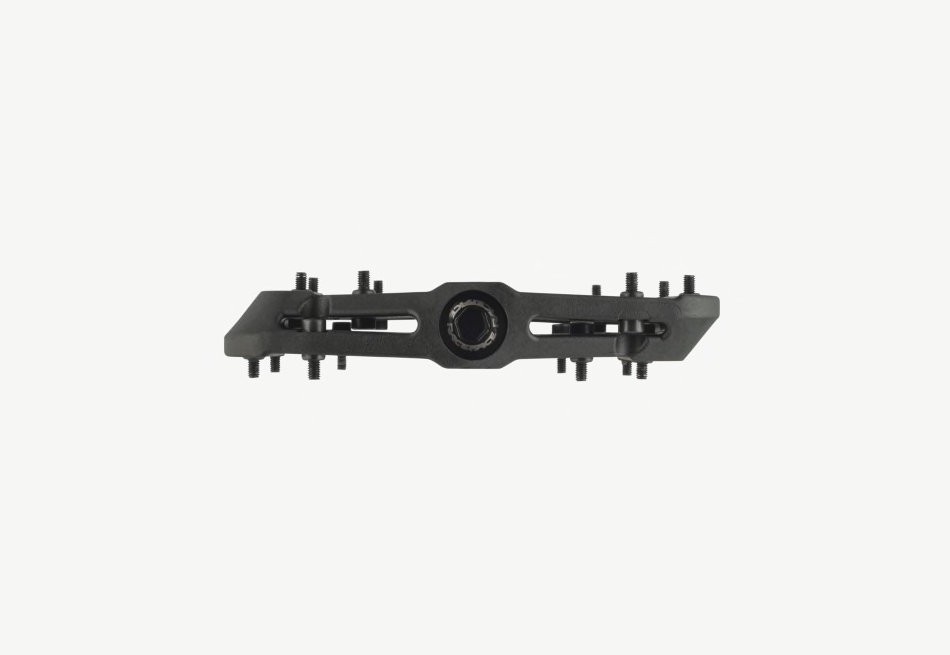
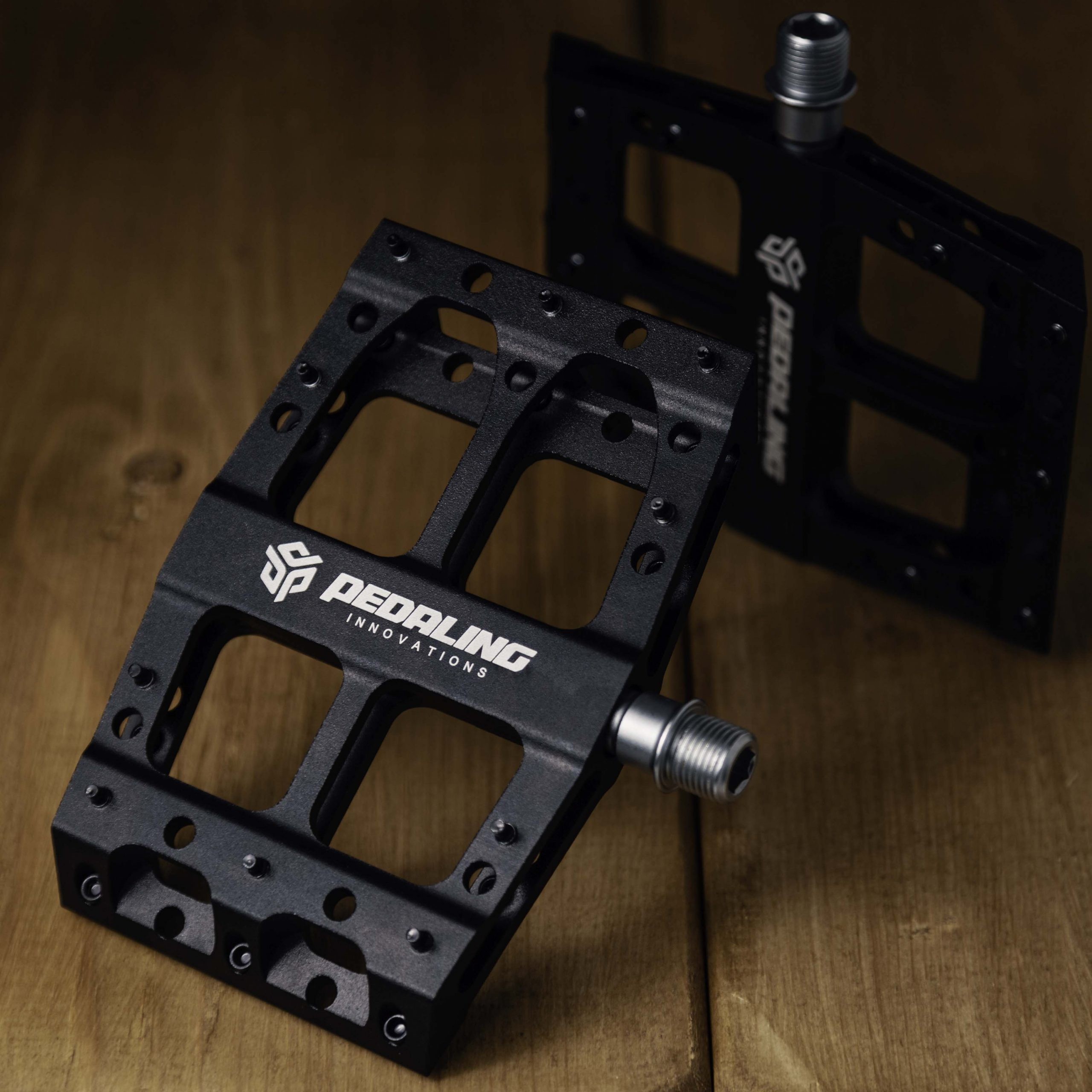
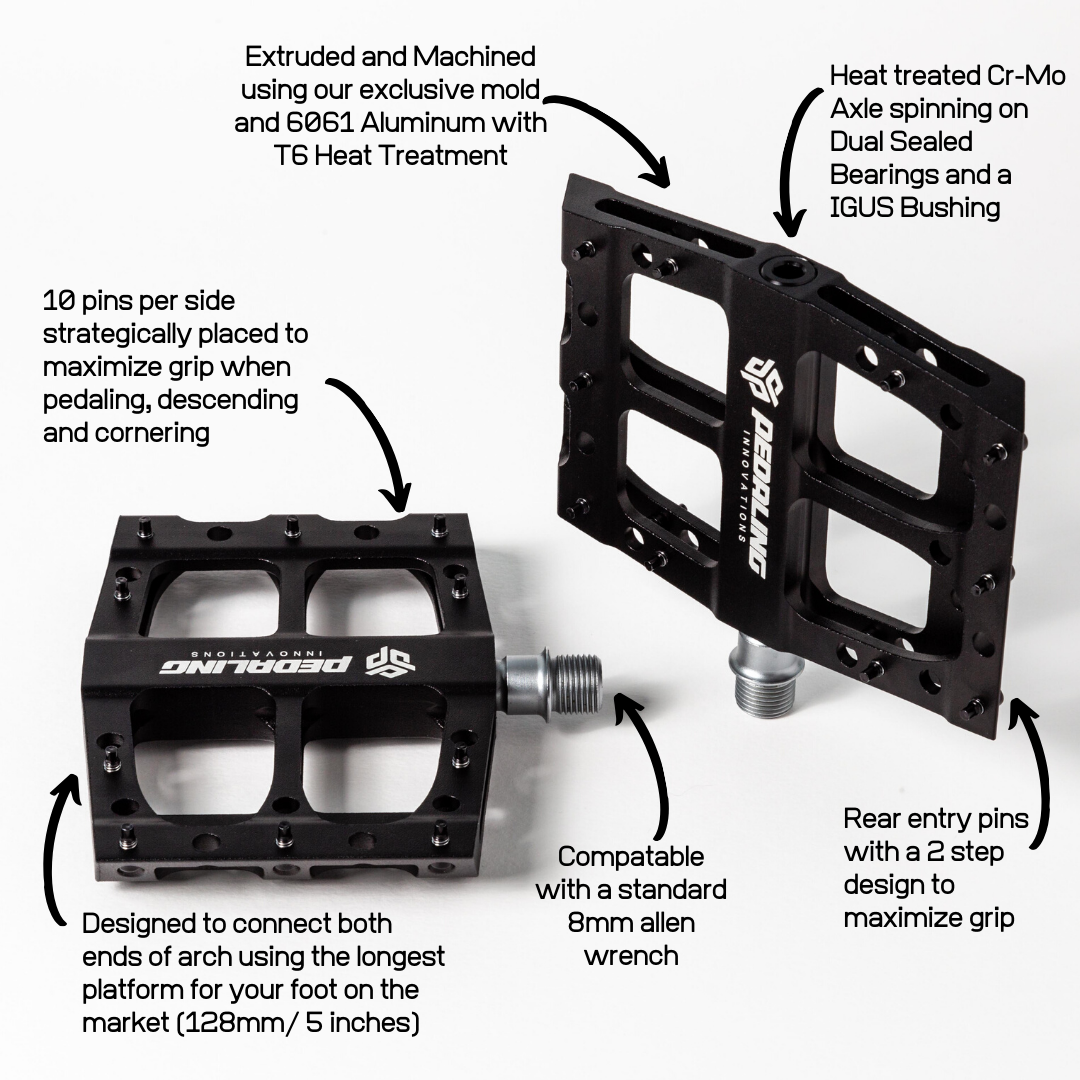
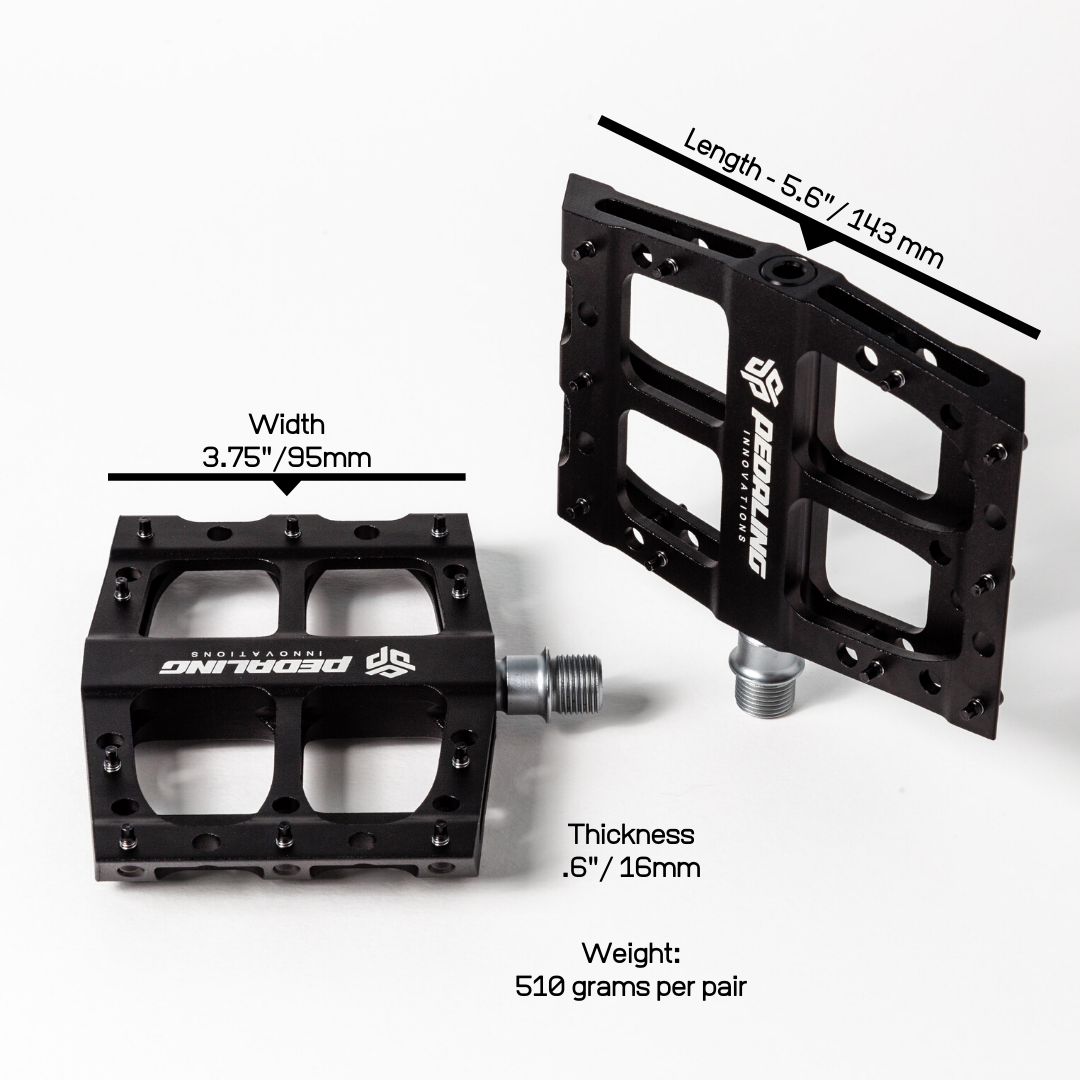
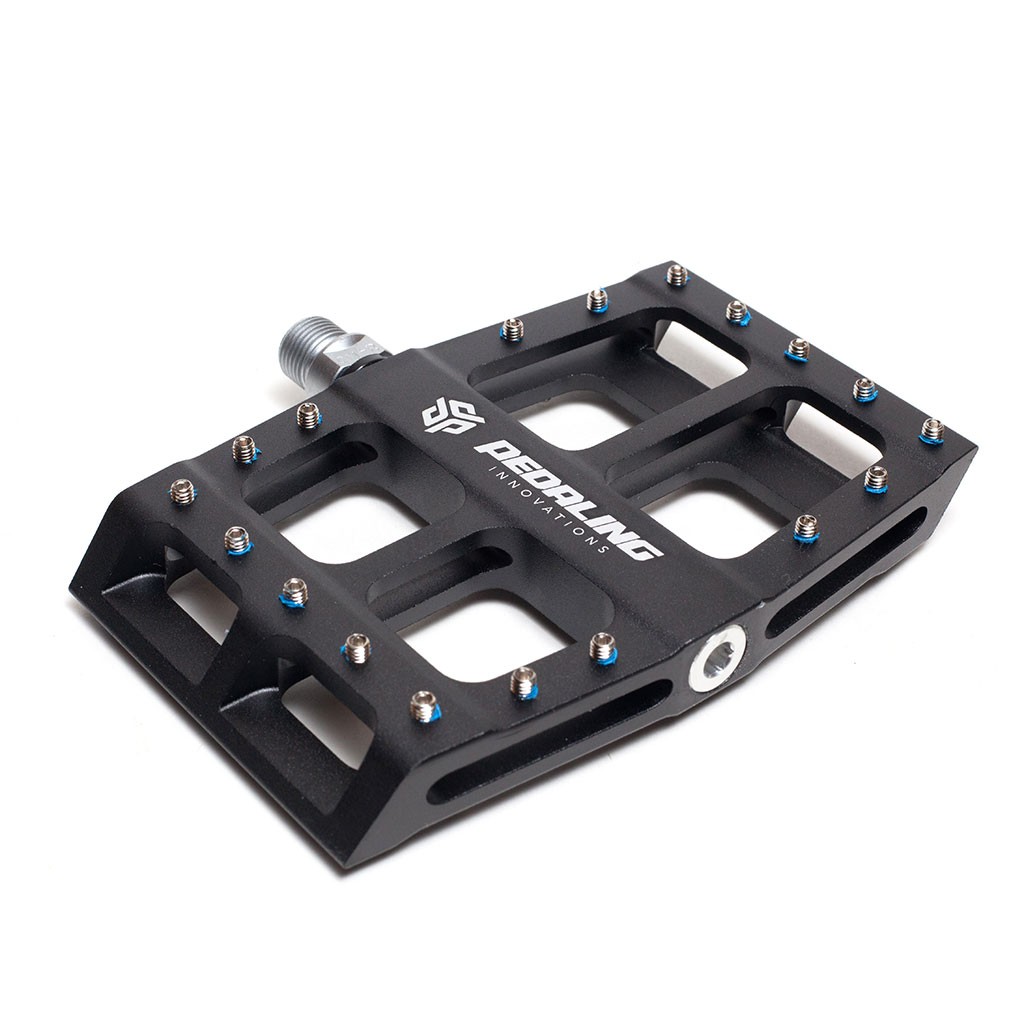
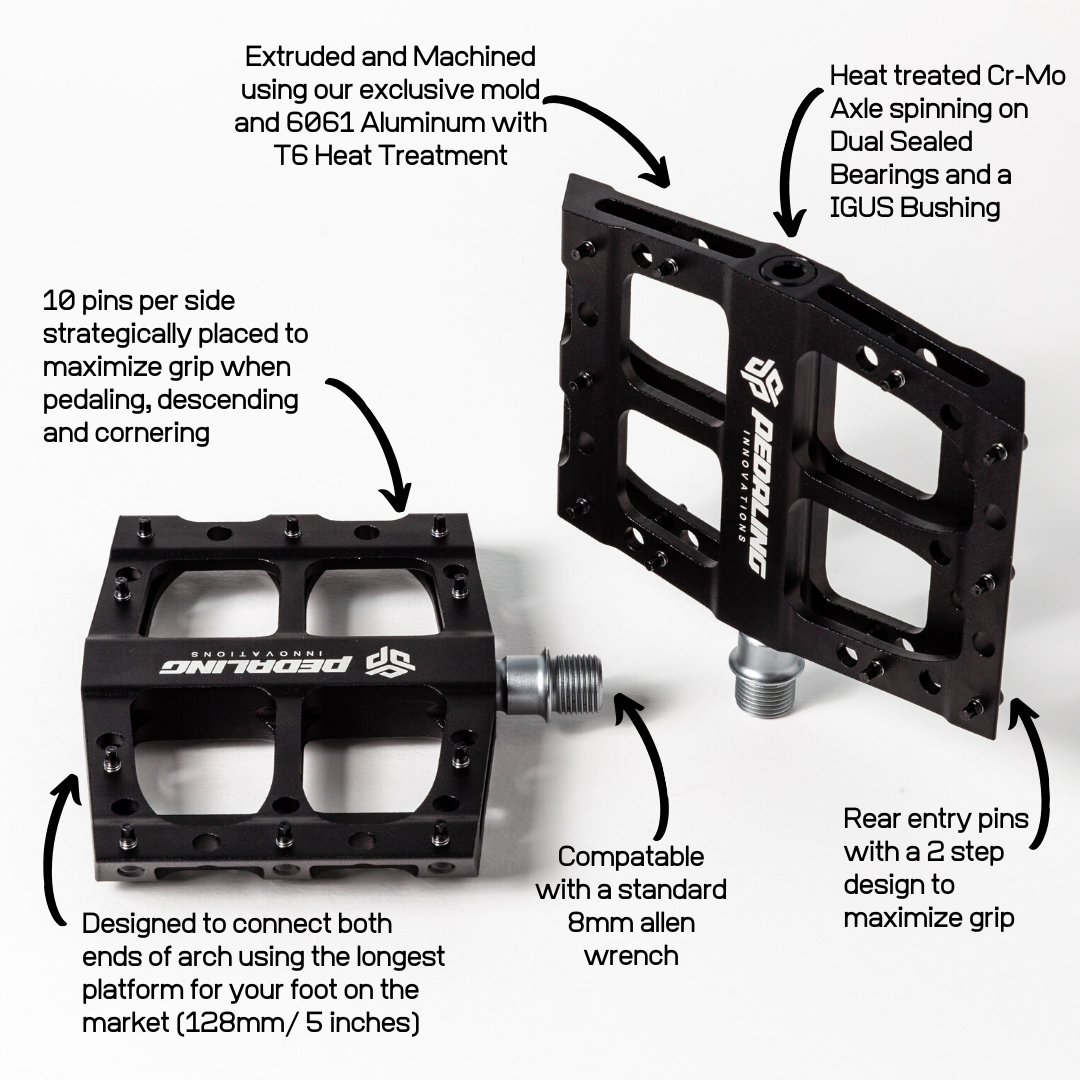
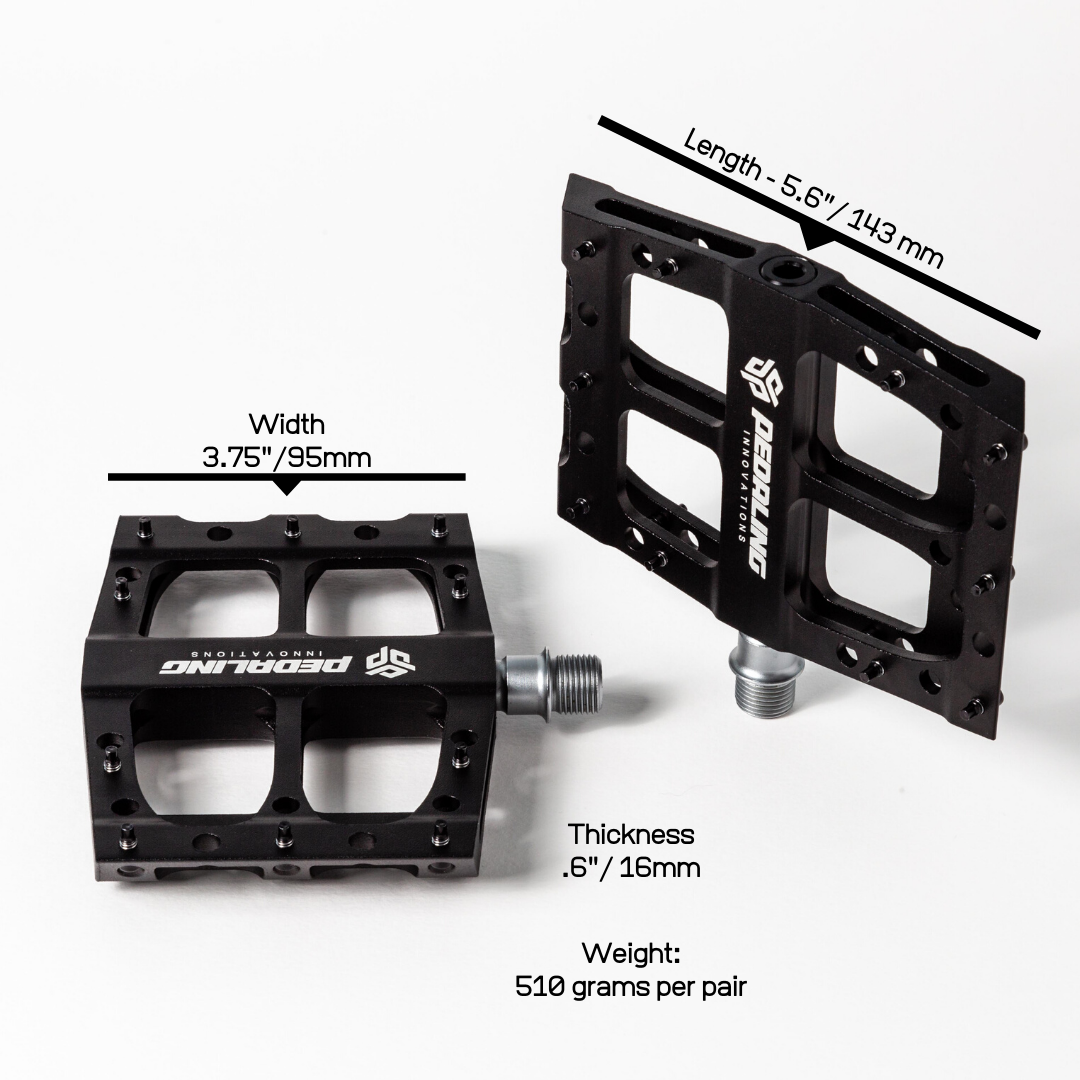
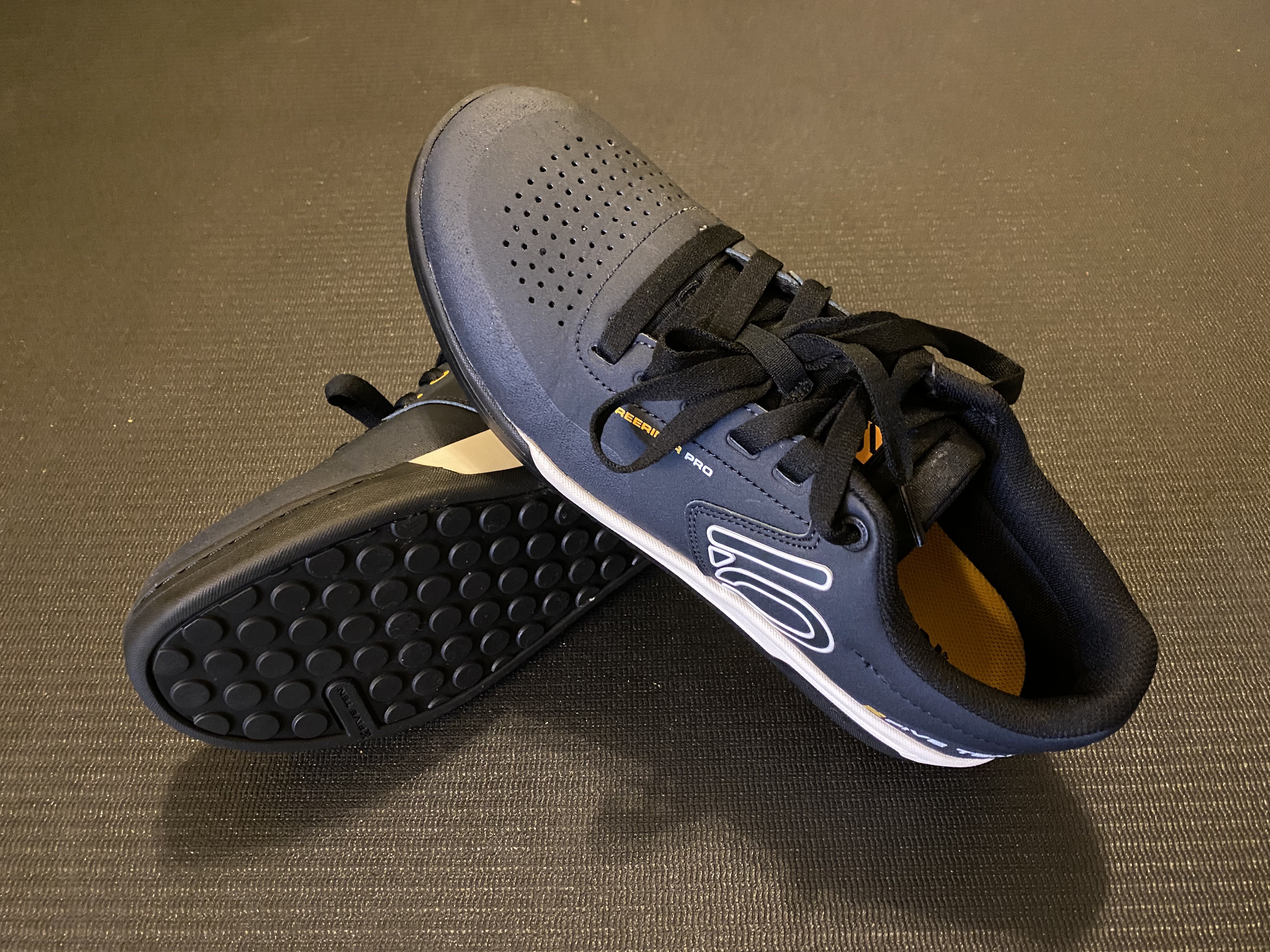
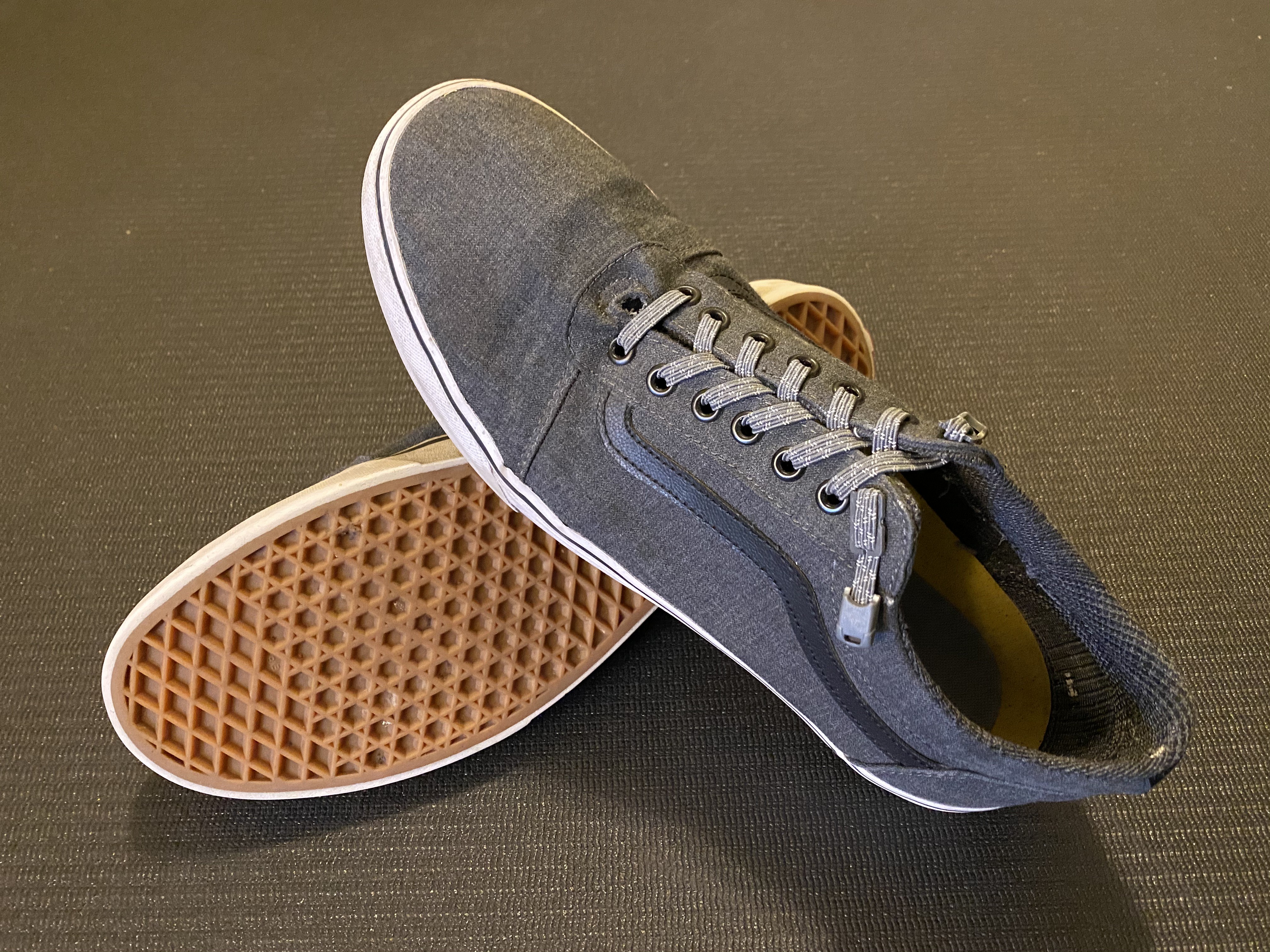
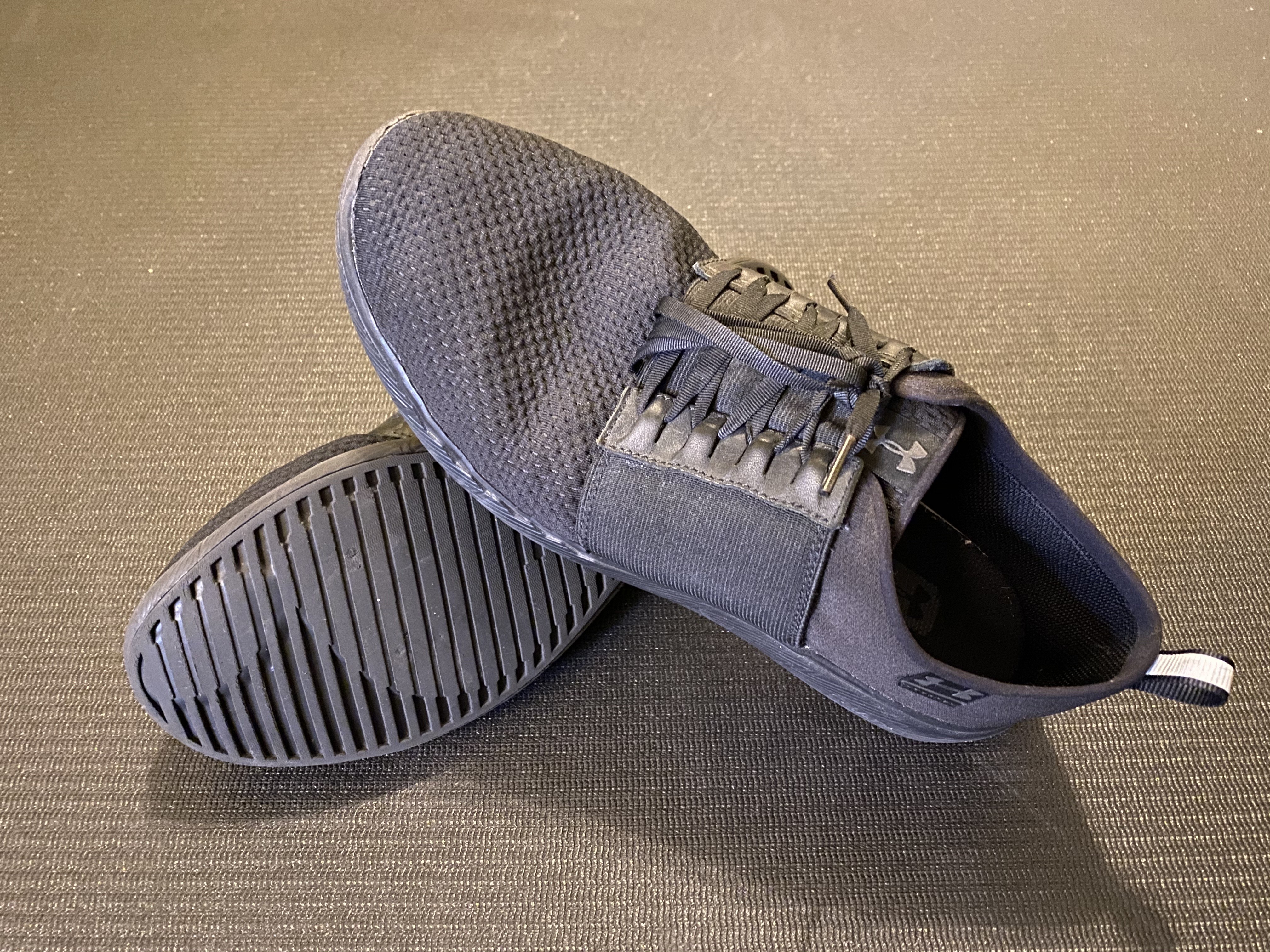
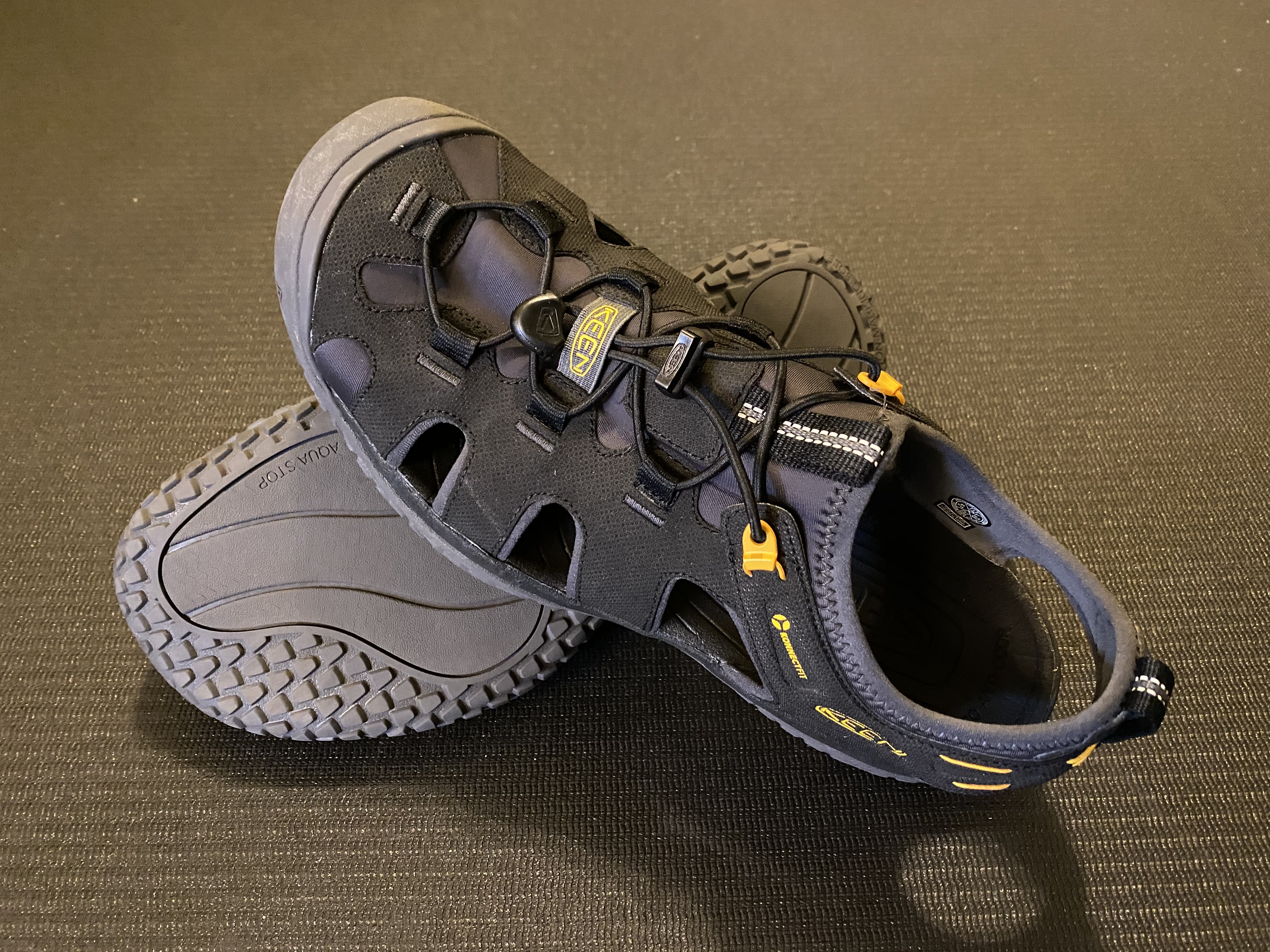
Post a comment!
Comments
I put the Catalysts on my eMTB for the start of this season. Today I hit 1,000 miles for the season. I'm not looking back; they've been fantastic for my 57 year old feet.
In fact today I'm putting flat pedals on my 1992 Klein Attitude that I'm rehabbing. I will be using it as a road/gravel bike (it's fully rigid). It's my last bike with clipless.
There are a few situations where I'll miss clipless. But they're far outweighed by the benefits of good flat pedals. One of them is being able to jump on any of my bikes in a pair of Vans BMX slip-ons and go, and be comfortable all day long without changing shoes. Another is mud never being an issue.
Speaking of that... every flat pedal cyclist should own a pair of Vans BMX slip-ons. :-). I have several of their BMX shoes but the canvas slip-ons are awesome in the summer. Soles on their BMX shoes have a little bit more beef to them versus their skate shoes, but they're just as comfortable and I still have pedal/ground feel. In my experience they also far outlast the skate slip-ons (including the skate pro slip-ons).
Nice article, very well written. Road cyclist here who tries to push performance from all angles. So much so I’ve destroyed my hips and just had them replaced. I’m currently 4wks into recovery and hope to be gently spinning in a few weeks. My plan is to go to flats to allow my legs and hip to find a natural position and not to risk clipless that could be slightly off and force my hip into an unnatural position. I too watched the GCN videos. They also did a follow up video about flats and the results were very encouraging. Hopefully, flats will be more comfortable and allow me to get training sooner. Thanks again. Andy.
I'm 65 and raced MTB clipless for many years. I recently got into gravel riding. Planning to do the Atlas mountain race which has a lot of hike a biking. I decided to try flats for the fun of it. I am so blown away I am in shock. They are so good. The versatility is crazy. Glued to the pedal and ability to change position is the game changer for me. Wearing my Keen sandals on my road bike with absolutely no difference in my Strava segments - you should see the grin on my face!
Hi Jeff, Last summer I started getting problem with my feet during a long 180km ride. The diagnosis is morton’s neuroma. Do you have information Whether the catalyst (in combination with wider shoes) will have positve effect?
Wow, that's a damn good question! I would imagine that the answer is, yes, it'll have a positive effect. That's especially true if you've been riding on clipless, which do have a tendency to put more pressure on the ball of the foot. Now, with platform pedals, a lot of them can still be narrow enough to require more pressure on the ball of the foot. There are a few that are pretty wide though...but not as wide as the Catalyst. I'd say give them a try and see just how much of a difference it makes.
Also, pop me a message on the Contact page and I'll get you in touch with James Wilson, the maker of the Catalyst pedal. I'm sure he'll have some solid feedback on this as well. Plus, if you decide to try out the pedals, he offers a full money back guarantee (for a full year I think).
Why not use a dual sided pedals? Oneside clipless other side is flat!! Best of both worlds as they say.
Very true. For anyone who wants to use both that's a good option. Only downside is that it takes some time to get used to clipping in and/or finding your footing. Have to get a really good pedal with balancing that allows for finding the flat or clipless side easily.
But for folks like me who just don't want to mess with clipless anymore a good flat pedal is the way to go. :D
Thanks, I've just made the switch over to flats. I'm old and I like the secure feeling of flat pedals. After a recent tip over caused by another rider stopping in front of me that caused some serious damage to my elbow and knee I decided I would go with flats. Still not used to them, clip in still seems more efficient but I now have more confidence when riding in congested situations with other riders around me.
I had those 510s and they were so heavy it made me feel clumsy. I switched to a 510 Trail Cross LT and it's so much better and lightweight. If you look to change in the future I would recommend those!
I actually bought some! I initially went with the Trail Cross LT but they felt weird to me and ended up going with some standard 510's. But after riding on hot summer days I revisited the Trail Cross LT's. Got a pair and, once I broke them in, I find they're absolutely great! :)
Good post. I also went from clipless for 7 years on my road bike to getting a mountain bike with flat pedals. I liked them so much I switched over to flat on my road bike and recent gravel bike and never look back. It's just simpler and I don't miss it. In fact I was going down hill on a blind curve and a dear crossed in front of me and I hit it but slowed down enough and for a foot off the pedal in time with my flat pedals and I walked away with just a scratch on my elbow and hit my head on the ground. If I was clipped in I don't know if it'd be worst but I imagine it would have sucked!
Man, I went down several times while trying to learn how to use clipless. I finally got it down and rode clipless for quite some time. It wasn't until I started going down while doing gravel rides that it became very apparent to me the serious downsides of clipless. :P
Thanks for a fantastic article. I've been wondering about flat pedals. Having just ridden 330 miles of the GDBR in Colorado (finished yesterday) I'm thinking flat pedals would be perfect for the kind of cycling I am doing as I get older (now 62). You've convinced me to try the Catalyst 1. It would seem to best mimic the feel I have with my clipless, where I set the cleats far back in my shoes.
Really great stuff. Look forward to reading more.
You bet! Thanks for the compliment! Truly appreciate it!
Getting back in the swing of things after a long hiatus. Got lots planned for the remainder of the year. :D
Great review and insights!
I got the Innovation Catalyst for my gravel bike along with the Five Tens. After being on clipless for 30 years, super strange feeling. Here's something to keep in mind for the person considering going the flat pedal route. What kind of terrain are you riding? I ride a combination of pavement, fire road and single track. Sometimes pavement is 60% (getting to dirt and back home from dirt). The flats were fine for the pavement and fire roads but not so much (for me) on single track because of my riding style (more aggressive). I ended up clipping the outside edge of the pedals somewhat often when going around tight turns and/or around rocks. My single track isn't serious mountain bike SS; it's just that some of the trails have some minor rocky sections.
So I sold the Innovations and went back to clipless (for now). I kept the Five Tens with the intention of ultimately getting another pair of flats once I move permanently to Australia where my riding will be quite different (longer pavement rides along the coast and more fire roads). But I just changed my mind on the Five Tens as I now remember they were too hot for me (especially shoulder seasons on either side of Summer). Also a big benefit (IMO) to flats is being able to ride in sandals (I'm looking forward to this in Oz).
Also, keep in mind that bunny hopping over curbs is not easy on flats. You can eventually do it, but you'll have to practice specific technique.
Happy Trails! 🚲🌞🚲
Thanks, Michael! Greatly appreciate it! :)
Another tip for flat pedals, especially those that have pins, is to give your feet a bit of a twist out. Basically, "screw your feet" into the pedals a bit. The benefit is that you'll get more grip and will find that you won't slip as much.
I agree though that flats aren't always a great joice with every terrain. No doubt there is some benefit to clipless in certain situations. The benefit of being "clipped in" and not having to worry about your feet slipping is certainly one of them.
Thanks for great article, Jeff. Im thinking to get catalyst pedals for my gravel bike as I already fallen few times in climbs. However when I tested my recommended foot position with axle under the arch I ended up with feet overlapping front wheel even with my 650b.Im not sure now . How did you found it, Jeff. Did you have same issue. Cheers
Hey Dušan, great article! Thank you for taking the time to research and write this. I am just getting into cycling, this is my second reason for riding a road bike and I initially used clipless pedals. After a few hairy moments last season, my confidence was shook, and so this season I bought the Bontrager line Elite Pros, and took some initial adjustment of foot placement, but wow! It is freeing!!!
Thanks for the compliment! Appreciate it! :D
Just looked up the Bontrager pedals you mentioned. Looks like a pretty solid set of pedals.
Damn good question! :)
To be honest, toe overlap is something that's kind of hard to avoid with gravel bikes. The reason is that most gravel bikes use more of a road bike geometry. Mountain bikes have more trail and thus avoid toe overlap issues due to the wheel being out more. On my bike, I still had to deal with some toe overlap even when using clipless pedals. The problem just get a bit more amplified with flats.
The good news is that, with most gravel riding, it's a non-issue. The reason is that, just like road riding, you're not making many sharp turns. When you do, you just need to be mindful, stop pedalling, and get your feet out of the way of the front wheel during the turn. I still bump my damn toe on the front wheel from time to time though. :P
This was helpful, thanks! For more of that locked in feeling, why not take a cue from the fixed gear community and use straps on your flats? Offend the hell out of the purists!
HA! Yeah, I imagine that would get quite a few peculiar looks from the usual suspects.
Your synopsis Of the GCN video is incorrect. They come out unanimously in support of clipped pedals due to better power transfer, consistent foot position and less leg muscle fatigue. Rewatch!
I did...and I heard some things a bit different this time around, especially on their first test. Pay attention to what the rider says near the end after the test, then part where he says he's "scratching his head a bit". Why did the test result in an edge toward flats for efficiency? The reason he surmises is that his pedaling style results in less pull up from his feet. But, he does say that in times when fast pedaling is required, like in sprints, that clipless would likely be more efficient...which they are.
The second video results were what I expected: sprints resulted in a huge increase in performance with clipless and results in all other areas were largely subjective. Keep in mind that these riders only spent a limited number of hours on flats. Remember the first time you rode clipless? How long did it take you to get used to them? A week or more, right? Same here. They really needed to ride on flats for a good week before doing this test. As such, what they're saying about clipless is a matter of preference. Their talk about calf engagement and such is more confirmation bias than anything. Simply put, they "prefer" clipless over flats based on the limited time they spent on the flats...which is perfectly fine.
Bottom line is this: If you prefer clipless and feel faster with them then stick with them. For everyone else, unless you're doing a lot of sprinting, for the average Joe rider there is likely to be no real difference in performance. At that point it boils down to personal preference.
I agree entirely regarding personal preference but you have stated as fact that “GCN did their own flat vs. clipless pedals test and found there to be no real difference”. This is untrue, their video was very clear there were considerable differences and ultimately recommended clipless for the majority of riders, even MTB. This is very different to what your article suggests. I’m not a clip or flat evangelist (I actually ride both for different purposes) but just pointing out the article inaccuracy.
I get what you're saying but I think I made it pretty clear that the one area where clipless reign supreme is in sprinting. That's exactly what GCN was getting at as well. Their take is that, whether you're on a road bike or doing MTB downhill runs, if you need to build up speed quickly then clipless pedals will do that more efficiently than flats. My take is that for everything else there is little to no difference in performance. Even GCN's own tests reveal that. It's just the sprints that are different.
Everything else is more of a feel thing. It's like when I got some Continental Grand Prix 5000 and rode them for the first time. Those things felt fast...but were they? Probably not. That's likely because I could feel the road more with them which gave me a false impression of speed. Reality is that they likely weren't any faster than the 35mm Rene Herse tires I run on now. Same thing applies to pedal choice I think.
But, when it comes to sprinting, I wholly agree that clipless pedals are better. Probably could have done a better job of saying that. :P
I have switched from road clipless to flat pedals with Five Ten shoes due to increasing frequency of falls. It has been a week since the change and I was wondering about how long it will take to regain efficiency that I had with clipless? I also put flat pedals on my trainer bike I use with Zwift to help the transition.
Hard to say really cause everyone is different. For me, it only took a few weeks to get where I felt like I was hitting the pedals well enough to where I didn't have to keep looking down at them when placing my feet. However, I will say that it took me a good month before I felt like I was placing my feet in the same position relatively consistently. In the end, it didn't take quite as much time as it did when I started using clipless.
Great article, hadn't heard of Catalyst before but wish did.
My main bike had been using MKS, and they are nice, no complaints, but really love the idea of a longer platform.
For what it's worth, my favourite shoes to ride with Tiger's Mexico 66, just need to ensure get the ones where fabric breathes. Those Under Armor Training shoes look appealing though!
It's funny, James Wilson and I talked about that very thing. Shoes are the one thing that people tend to think has to be cycling specific. But with the Catalyst pedals, that problem practically becomes non-existant. Heck, I ride a lot with my Van's and, during the summer, my sandals. Makes casual rides a lot more fun for sure. :D
Thanks for a well thought and intresting article. My choice is to use double sided pedals when riding with my rigid Kona Unit X. On rough terrain I like to use clipless side for better and safer staying on the bike and on technical (slower) sections I change flat side. It's little bit cumbersome and changing sides during ride makes you tad slower, but personally I still prefer this method.
When cycling with my Nicasio I use 98% of time clipless side. Flat side is for example goin to grocery etc.
I have noticed some differences when comparing these. I think calves and hamstring are more involved when using clipless and flat side mainly trains quadriceps.
I get the feeling of safety with clipless. That's another reason most of us would want to use clipless. Personally, I don't think the safety of clipless is all that. Since switching to flats, I've found that optimizing the pins on the pedals can improve grip quite a bit. If I'm in a sticky situation, I can get more grip by simply pressing and rotating my feet out a little. Never felt unsafe on flats as of yet. Only one time did I think my feet would slip but that's only because I was pedaling rather lightly and my feet weren't well planted.
As for your calves and hamstrings, you're absolutely right. That is due to the position of the clips on your shoes. If you can pull them back as far as you can on your shoes that'll help some. Might need to adjust your saddle position when you do though. That's one of the downsides of clipless. If they made a shoe that offered more of a mid-sole position, it would be greatly improved...but they don't...that is unless you make one yourself or get one customized for it. :P
Thanks for reading! :D
They actually do. Heinz Goetze, a former german pro sell a shoe brand call Biomac, just google. That's real midfoot. Otherwise you got the adapters from patrol cleats, not real 100% midfoot, but close.
Jeff, you are pretty brave to be poking the "clipless versus flats" bear! Nothing pushes people quicker into name-calling on Facebook than this topic. I believe you have discovered something that I figured out a few years ago--that clipless systems are GREAT... if you are an elite-level sprinter. For the rest of us, clipless pedals probably have far less benefit than advertised. With my mind wide open and even a little biased toward clipless pedals, I bought a nice set of Shimano shoes and pedals around 2015 or so. The shoes fit fine, so no problem there. I rode several of my regular 20-mile circuits over a period of about 6 weeks and found practically no measurable speed benefit when compared to my flat pedals, even on hills. As for the substantial list of negatives, I realized quickly that jetting away from a stoplight in traffic was hampered by the clip-in process versus flat pedals. I could no longer ride all day, stopping in neighboring towns for some sightseeing and/or walking, unless I wanted to strap a pair of normal shoes to my bike. Add to these cons the inability to quickly get a foot down for balance should the smooth pavement suddenly have gravel or a slick spot. I like that I can balance at a stoplight far longer than my clipped-in friends because I'm not worried about unclipping at the last second to put my foot down. As you mentioned, comfort on long rides is compromised by being locked into a specific geometry. For the vast majority of road bike riders, clip-ins are like giant spoilers on a passenger car; they are unnecessary for regular people, but we buy them because we see racers using them, even though we can't possibly benefit from their use. Oh, and I really like the Shimano MX-PD80 flats that I installed on my Ridley road bike after the clipless experiment. The Catalyst models you discussed look pretty awesome, so maybe if the MXs ever wear out, I'll consider those.
As an IP camera recorder, it operates smoothly and efficiently, capturing high-quality footage. The inclusion of time-lapse recording is a welcome addition, simplifying the review process. If you are searching for a comprehensive VMS to enhance your security, look no further than SmartVision. This video surveillance software has significantly improved my peace of mind and is a worthwhile investment. https://www.oneidauniversity.com/
Thanks for the comment! Fantastic insights into your own journey with clipless vs flats. I ate my lunch a few times on group rides with my first clipless pedals. Quit embarrassing. I talked with James Wilson of Pedaling Innovations recently. Will be releasing a podcast soon with that conversation. :)